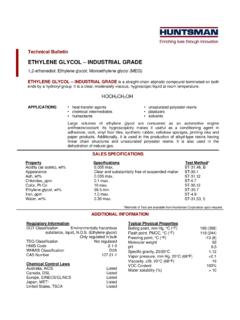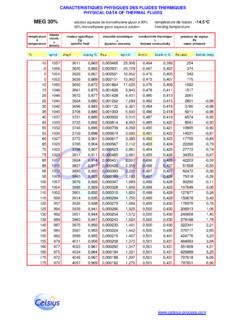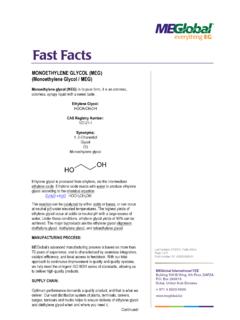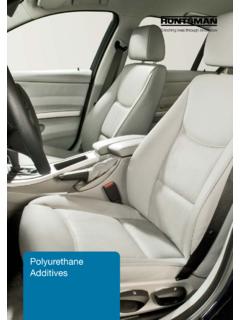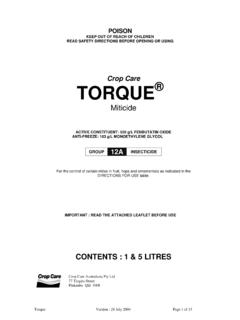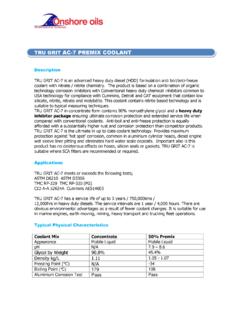Transcription of MONOETHYLENE GLYCOL - Orica
1 Safety Data Sheet1. IDENTIFICATION OF THE MATERIAL AND SUPPLIERP roduct Name: MONOETHYLENE GLYCOLO ther name(s): ethylene GLYCOL ; MEG; 1,2-Ethanediol; 1, Use of the Chemicaland Restrictions on UseCoolant and antifreeze; heat transfer agent; brake fluids; solvent; :Ixom Operations Pty LtdABN:51 600 546 512 Street Address:Level 8, 1 Nicholson StreetEast Melbourne Victoria 3002 AustraliaTelephone Number:+61 3 9906 3000 Emergency Telephone:1 800 033 111 (ALL HOURS)Please ensure you refer to the limitations of this Safety Data Sheet as set out in the "Other Information" section at the end of this Data HAZARDS IDENTIFICATIONNot classified as Dangerous Goods by the criteria of the Australian Dangerous Goods Code (ADG Code) for transportby Road and Rail.
2 NON-DANGEROUS material is hazardous according to Safe Work Australia; HAZARDOUS of the chemical:Acute Oral Toxicity - Category 4 Specific target organ toxicity (single exposure) - Category 3 Specific target organ toxicity (repeated exposure) - Category 2 SIGNAL WORD: WARNINGP roduct Name: MONOETHYLENE GLYCOLH azard Statement(s):H302 Harmful if May cause respiratory May cause damage to organs through prolonged or repeated : 26/11/2018 Substance No: 000030116701 Precautionary Statement(s):Prevention.
3 P260 Do not breathe mist, vapours, Wash hands thoroughly after Do not eat, drink or smoke when using this Use only outdoors or in a well-ventilated : 5 Response:P301+P312 IF SWALLOWED: Call a POISON CENTER or doctor/physician if you feel Rinse +P340 IF INHALED: Remove person to fresh air and keep comfortable for Call a POISON CENTER or doctor/physician if you feel Get medical advice/attention if you feel 1 of 7 Safety Data SheetStorage:P403+P233 Store in a well-ventilated place. Keep container tightly Store locked :P501 Dispose of contents and container in accordance with local, regional, national, international Schedule (SUSMP):S6 COMPOSITION AND INFORMATION ON INGREDIENTSC omponentsCAS NumberProportionHazard CodesEthylene glycol107-21-1100%H302 H3734.
4 FIRST AID MEASURESFor advice, contact a Poisons Information Centre ( phone Australia 131 126; New Zealand 0800 764 766) or :Remove victim from area of exposure - avoid becoming a casualty. Remove contaminated clothing and loosenremaining clothing. Allow patient to assume most comfortable position and keep warm. Keep at rest until fullyrecovered. If patient finds breathing difficult and develops a bluish discolouration of the skin (which suggests a lack ofoxygen in the blood - cyanosis), ensure airways are clear of any obstruction and have a qualified person give oxygenthrough a face mask.
5 Apply artificial respiration if patient is not breathing. Seek immediate medical Contact:If skin contact occurs, remove contaminated clothing and wash skin with running water. If irritation occurs seekmedical Contact:If in eyes, wash out immediately with water. In all cases of eye contamination it is a sensible precaution to seekmedical Name: MONOETHYLENE GLYCOLI ssued: 26/11/2018 Ingestion:Rinse mouth with water. If swallowed, do NOT induce vomiting. Never give anything by the mouth to an unconsciouspatient.
6 Seek immediate medical No: 000030116701 Indication of immediate medical attention and special treatment needed:Treat symptomatically. Following ingestion admission to hospital should be the first priority. Gastric lavage or emesisshould be performed as soon as possible to minimise absorption and is recommended within four hours of lavage or emesis should not be attempted unless medical expertise or adequate facilities are may be given intravenously as an antidote to prevent build-up of toxic metabolites and increase excretion ofunchanged ethylene GLYCOL by the kidneys.
7 Uraemia, pulmonary oedema and metabolic acidosis can occur anddialysis, preferably haemodialysis, may be employed to treat these complications and to remove ethylene GLYCOL andits metabolites from the blood. ethylene GLYCOL can cause central nervous system depression and metabolic removal by gastric lavage. Blockade of the diacid/hydroxyacid metabolites may follow competitive inhibitionof alcohol dehydrogenase with ethanol or 4-methyl pyrazole. Consider maintenance of a plasma ethanol level of 100mg/dL to 150 : 55.
8 FIRE FIGHTING MEASURESPage 2 of 7 Safety Data SheetSuitable Extinguishing Media:Fine water spray, normal foam, dry agent (carbon dioxide, dry chemical powder).Unsuitable Extinguishing Media:Water hazards arising from the chemical:Combustible protective equipment and precautions for fire-fighters:On burning will emit toxic fumes, including those of oxides of carbon . Fire fighters to wear self-contained breathingapparatus and suitable protective clothing if risk of exposure to vapour or products of combustion.
9 Heating can causeexpansion or decomposition of the material, which can lead to the containers exploding. If safe to do so, removecontainers from the path of fire. Keep containers cool with water ACCIDENTAL RELEASE MEASURESE mergency procedures/Environmental precautions:Clear area of all unprotected personnel. Shut off all possible sources of ignition. If contamination of sewers orwaterways has occurred advise local emergency precautions/Protective equipment/Methods and materials for containment and cleaning up:Slippery when spilt.
10 Avoid accidents, clean up immediately. Wear protective equipment to prevent skin and eyecontact and breathing in vapours. Work up wind or increase ventilation. Contain - prevent run off into drains andwaterways. Use absorbent (soil, sand or other inert material). Collect and seal in properly labelled containers ordrums for disposal. Wash area down with excess HANDLING AND STORAGEC lassified as a C2 (COMBUSTIBLE LIQUID) for the purpose of storage and handling, in accordance with therequirements of AS 1940.





